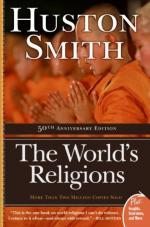
|
| Name: _________________________ | Period: ___________________ |
This test consists of 15 multiple choice questions and 5 short answer questions.
Multiple Choice Questions
1. According to Hinduism who has the spiritual ideas of infinite being, infinite awareness, and infinite bliss?
(a) Only one individual per lifetime has this knowledge.
(b) All humans already posses these things but until a certain point they remain hidden.
(c) Only the oldest gurus understand these things.
(d) Only philosophers can possess that information.
2. How does Hinduism teach that pain can be endured?
(a) By certain natural pain inhibitors taken orally
(b) By avoiding situations that have a potential for pain
(c) By learning to enjoy the sensations of pain
(d) By focusing on that which distracts the mind from the pain itself
3. What historical event occurred just as Confucius began teaching?
(a) The birth of Mohammed
(b) The Peloponnesian War
(c) The arrival of Marco Polo
(d) The collapse of the Chou Dynasty
4. Why does Hinduism stress what the human mind must leave out?
(a) Because human mind is adapted to deal with the universe.
(b) Because human mind is adapted to deal with the family.
(c) Because human mind is adapted to deal with money.
(d) Because human mind is adapted to deal with the finite.
5. How did the Taoist church devise a way of harnessing higher power for human benefit?
(a) By perfecting astrology
(b) By organizing religious retreats
(c) By opening schools for magicians
(d) By assuming the reality of magical intervention
6. What did the Buddha write during his lifetime?
(a) Nothing
(b) The Vidas
(c) The Buddhist Bible
(d) The Sangha
7. What is the Taoist outlook on good and evil?
(a) They are representations of heaven and earth.
(b) They have nothing to do with yin/yang.
(c) They are one and the same thing.
(d) They are not opposites but revolve around each other.
8. Who profits most from raja yoga?
(a) Those of royal lineage
(b) Those who have not achieved mental clarity
(c) Those who visit ashrams
(d) Those with a scientific bent
9. What is the idea behind karma yoga as work?
(a) You get what you work for.
(b) Work becomes habit which frees the mind for enjoyment.
(c) Work keeps you centered on self.
(d) By concentrating on work with a kind of detachment, there is no time for selfishness.
10. What is the viewpoint of the Theravada Buddhist?
(a) It proposes a collective attempt to reach nirvana.
(b) It denies the idea of reincarnation.
(c) It teaches that only monks can reach enlightenment.
(d) It insists that the path to enlightenment is up to the individual.
11. What is the sangha?
(a) A permit to travel
(b) A Buddist religious order
(c) A tree that grows in India
(d) A type of beer
12. How was the "Old boy" of Taoism often seen?
(a) Riding off on a water buffalo
(b) Riding off on a donkey
(c) Riding off on a white horse
(d) Riding off on an ostrich
13. What appears to be a contradiction in Taoist thought?
(a) The earthly versus the esoteric
(b) The ideas of reality and the supernatural
(c) The idea of teaching the unteachable
(d) The three different senses
14. How does Sri Ramakrishna illustrate the experience all the great world religions?
(a) He says each experience will reach a different goal.
(b) He suggests that such questions are frivolous.
(c) Whether you climb a ladder, a rope, or a bamboo pole, you still reach the same goal.
(d) He advocates trying out all religions for the best fit.
15. What do (1) the brahmin, or seer; (2) the kshatriya, or administrator; (3) the vaishya, or producer; and (4) the shudra, or servant represent?
(a) The divisions of monks
(b) The levels of education
(c) The stations of life
(d) The highest forms of yoga
Short Answer Questions
1. What is the Hindu concept of galaxies of finer or courser natures?
2. What is the ultimate reality of Taoism?
3. What is the central characteristic of the Sikh?
4. What does the Tao Te Ching say about Taoism?
5. What is the irony of Buddhism and India?
|
This section contains 747 words (approx. 3 pages at 300 words per page) |

|




